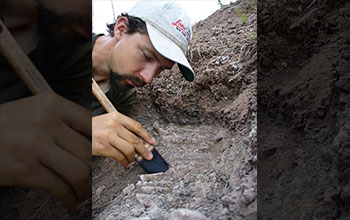Multimedia Gallery
Excavating a fossil in Tanzania
University of Washington student paleontologist Christian Sidor excavates a fossil in Tanzania.
More about this image
In 2013, researchers at the University of Washington announced their findings from a study of newly discovered fossils dating from 10 million years after the mass extinction that caused nine out of 10 species on Earth to disappear 252 million years ago. The fossils reveal a lineage of animals thought to have led to dinosaurs in Tanzania and Zambia.
That's still millions of years before dinosaur relatives were seen in the fossil record elsewhere on Earth.
"The fossil record from the Karoo of South Africa, for example, is a good representation of four-legged land animals across southern Pangea before the extinction," says Christian Sidor, a paleontologist at UW and lead author of the study published in 2013. "After the extinction, animals weren't as uniformly and widely distributed as before. We had to go looking in some fairly unorthodox places." Pangea was a landmass in which all the world's continents were once joined together. Southern Pangea was made up of what is today Africa, South America, Antarctica, Australia and India.
The insights come from seven fossil-hunting expeditions in Tanzania, Zambia and Antarctica funded by the U.S. National Science Foundation. Additional work involved combing through existing fossil collections.
To learn more about this research, see the NSF news release What happened to dinosaurs' predecessors after Earth's largest extinction 252 million years ago? (Date image taken: 2003-2013; date originally posted to NSF Multimedia Gallery: Nov. 15, 2017)
Credit: Linda Tsuji
Images and other media in the National Science Foundation Multimedia Gallery are available for use in print and electronic material by NSF employees, members of the media, university staff, teachers and the general public. All media in the gallery are intended for personal, educational and nonprofit/non-commercial use only.
Images credited to the National Science Foundation, a federal agency, are in the public domain. The images were created by employees of the United States Government as part of their official duties or prepared by contractors as "works for hire" for NSF. You may freely use NSF-credited images and, at your discretion, credit NSF with a "Courtesy: National Science Foundation" notation.
Additional information about general usage can be found in Conditions.
Also Available:
Download the high-resolution JPG version of the image. (654.4 KB)
Use your mouse to right-click (Mac users may need to Ctrl-click) the link above and choose the option that will save the file or target to your computer.

 All images in this series
All images in this series